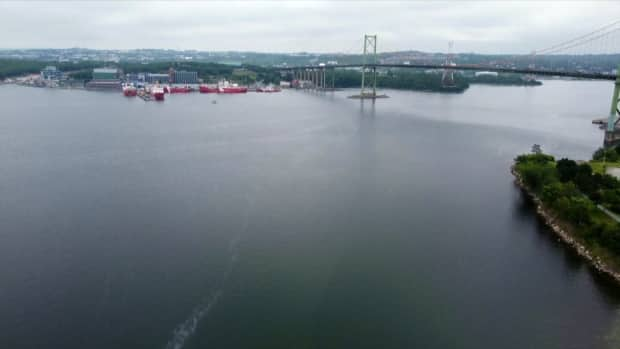Mild winter could lead to record-low oxygen levels in Bedford Basin

Unusually low oxygen levels in Bedford Basin this summer present a high risk that deep water in the basin will temporarily become totally devoid of oxygen for the first time, according to a scientist monitoring the inland bay adjacent to Halifax harbour.
Doug Wallace says "anoxic" conditions would pass but are a potential harbinger of climate change — although not everyone agrees the situation is dire or unusual.
"We're starting to see some very surprising things which we believe are linked certainly to weather conditions, but also to climate change," said Wallace, a professor of chemical oceanography at Dalhousie University in Halifax and Canada Research Chair in Ocean Science and Technology.
He also serves as science director of the Marine Environmental, Observation, Prediction and Response Network (MEOPAR). The research centre has received $53 million from Ottawa to promote the study of Canadian marine conditions.
The risk from anoxic conditions is an accumulation of hydrogen sulfide (H2S) gas produced from the microbial breakdown of organic matter. The gas is toxic to fish and most other marine life.
It is about what did not happen in 2021
A mild winter meant colder, oxygen-rich water at the surface did not sink to the bottom of the basin. There was no vertical mixing or "overturning" this winter.
"We think that's an extremely unusual situation," Wallace said.
A flow of offshore water periodically driven into the basin by prevailing winds has not happened either. These "intrusion" events replenish oxygen.
The result at depth, said Wallace, are oxygen levels one-third to half of normal at this point of the year.
"We think the implications are that there's a potentially high risk, a much higher risk than maybe ever before," said Wallace in an interview. "And I use those words cautiously because you've got to be really careful of the bottom water in Bedford Basin becoming anoxic, that is devoid of oxygen."
Without an intrusion from the Scotian Shelf to reset the water column, zero oxygen levels in deep water could happen as soon as August, he said.
A contrary view
The Department of Fisheries and Oceans has been measuring conditions since 1992.
Andrew Cogswell recently stepped down as director of the Bedford Basin Monitoring Program after seven years.
He and Wallace have a collegial difference on the rarity of what is happening this year.
Cogswell agrees oxygen levels are unusually low this summer and that there has been no spring intrusion or winter overturning this year.
However, he said none of that is very unusual.
In the deepest parts of the basin — below 60 metres— oxygen levels are 1.5 millilitres per litre, which Cogswell says is "not atypical" over the last 22 years.
"We've seen the basin conditions at the bottom become anoxic in the past where oxygen is essentially zero," he said. "But … in the fall of this year, leading up to the winter, we're likely to see intrusion events that will increase the oxygen."
Wallace disgrees, saying similar conditions prevailed in 2006 but were less extreme.
"It is not clear to me that truly 'anoxic' waters have ever been observed," he said.
"Anoxia means zero oxygen and usually implies measurable buildup of H2S. This is very different from 'hypoxia' which is the term used for low-oxygen conditions. The two conditions have different implications for chemistry and animal and microbial life."
Bedford Basin reached 22 C last week
There is no debate about temperatures in the Bedford Basin in 2021.
The surface hit 22 C last week — up to four degrees above average, outside normal variations and weeks ahead of the usual summer peak which typically occurs in late August, said Cogswell.
"Temperatures are increasing at the surface in the basin," he said. "They have been over time in response, I believe, to climate change. With increasing temperatures, there is obviously a decline in the amount of oxygen that the water can hold."
Surface temperatures are variable and a record warm surface temperature can disappear with a few days of cold rain.
Wallace notes bottom water temperatures are also above normal this summer.
"Another indication that mixing did not extend to the bottom," he said.
Oxygen in Bedford Basin
This is not an issue in the top layer because tides mix surface waters in the eight-kilometre-long, five-kilometre-wide basin. The enclosed bay is linked to Halifax harbour at the aptly named Narrows.
At depths below 30 metres, mixing is much less frequent. Very low oxygen levels at the bottom are not uncommon although they generally occur later in the year.
The basin sea floor is 70 metres at its deepest point.
Wallace acknowledges the next intrusion will replenish the basin and there is no long-term record to document a trend.
But, he says, warmer winters could make winter overturning less frequent and anoxic conditions more likely in future.
"I think what you might be seeing here is this idea of extreme events," he said. "You have a higher risk or freak chance of an extreme event that pushes the system into a new state where it normally isn't. So this would be consistent with that sort of idea that as we go to a warmer and warmer or an altered climate, that the probability of an extreme event increases."
Both Wallace and Cogswell agree that monitoring in the basin for climate change impacts is needed.
If anoxic conditions do become more common, Wallace says scientists and governments need to consider what happens if hydrogen sulfide builds up and how it might disperse.
"This isn't a new phenomenon globally, but I still think it's a major surprise here," he said. "I don't think we really expected that this would happen in this way, that the winter mixing wouldn't happen at all, and that the bottom of the basin becomes anoxic."
MORE TOP STORIES
